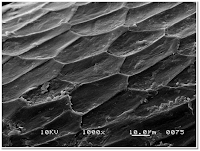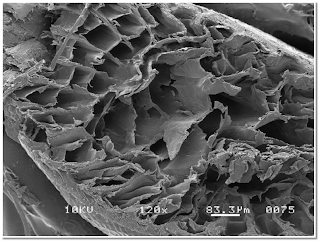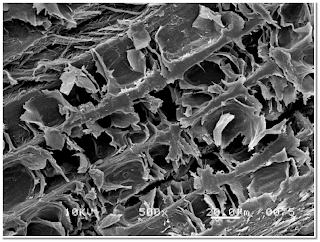There's an insane amount of detail in the world that we never see. Not just the Sherlock Holmes-like attention to environment and behaviour, but the underlying structure of things. Random little things that you never expected.
For a microscopy project, I needed to select something unusual to image with both SEM (scanning electron microscopy, which is launching electrons at a surface to look at details that are so tiny even light waves are too big to show you what's happening) and AFM (atomic force microscopy by dragging a tiny tiny needle across the surface of things like it's reading molecular Braille).
When I came home, the most unusual thing on hand was my pet hedgehog, Ada.
I took samples of her quills and some baby quills from the breeder
Hamor Hollow to compare how sharp the quills were at different ages.
Look at a quill with the naked eye and you wonder...What's that made out of? What is it really shaped like? How does that grow to be? I thought of pins or needles the way I've seen them for sewing. Surely nothing more complicated than the ring-like growth pattern of trees. I've pet Ada and felt quills, so I could confidently tell you the sides were smooth.
No. All of my guesses were right off.

Looking at a quill from a baby, we can consider the pokey-pokey factor to be significant. For comparison, the metal of a light use razor is about 127 um thick, narrowing down to microns (and depending on the use).
Adult quills look similar, but the tips become increasingly worn on older quills, like a razor blade.
After the AFM scan, it turns out the edges of quills have lots of little flakes. Like human hair that you seen in all those shampoo commercials.
The first image (brown scale) is the scan of the boundary between two of the flakes on a single quill, showing the changes in depth like a topographic map. On the SEM image of a baby quill (gray scale) you can see how much smoother the flakes are when the quill is brand new.

A cross section showed hundreds of hollow unit cells. Well sure, if you're an 8-16 ounce animal, you want your protective armor to be light and transportable. Of course. My brilliant plan to scan the cross section with the AFM was totally thwarted. The tip of the probe that does the scanning is so tiny it would get stuck a thousand times a scan over that surface. That surface should be a little more orderly, too. Cutting the sample for preparation was apparently a little sloppy.
And the hollows in the quills grow lengthwise, with a series of stronger internal support along the length of the quill. Not extruded like play-dough, the way I'd imagined.
At the very least, I'm glad I guessed about all this, because I wouldn't have realized how wrong I was any other way.








